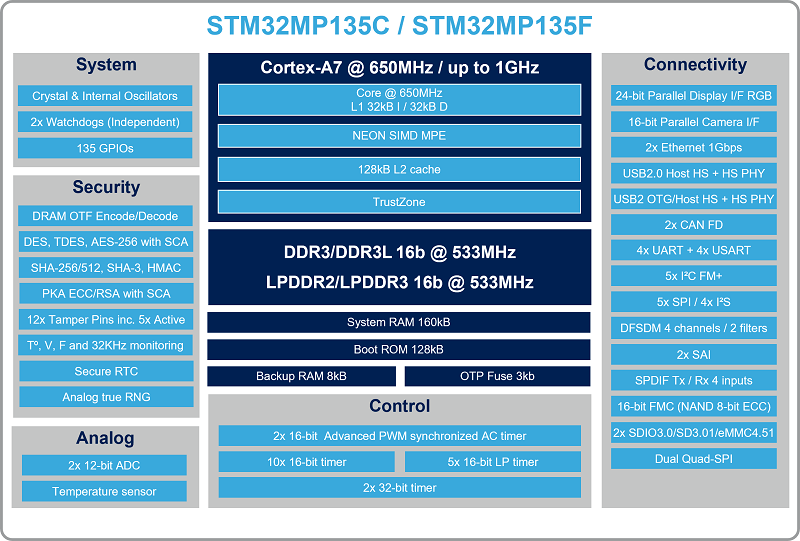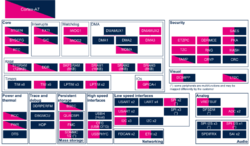STM32MP13 microprocessors are based on the Arm® Cortex®-A7, supporting Trustzone® mode for secure operations.
This article starts with information on STM32MP13x lines ![]() part number codification and block diagram. STM32MP13 is part of STM32MP1 series (refer to the list of part numbers provided below).
part number codification and block diagram. STM32MP13 is part of STM32MP1 series (refer to the list of part numbers provided below).
Then technical aspects are introduced, providing information on:
- STM32MP13 documentation
- articles dedicated to internal peripherals that allow a transition to the software frameworks required to control these peripherals
- the list of boards supporting STM32MP13 devices
- the supported software distributions, that can be downloaded into the STM32MP13 device.
1. Introduction[edit | edit source]
STM32MP13x microprocessors are targeting industry 4.0, factory automation, smart metering, smart homes, electric vehicle charging infrastructure applications and point of sales (PoS) applications.
They are are based on a single Arm® Cortex®-A7 core running up to 1GHz, with a rich set of connectivity options, such as dual Gigabit Ethernet.
2. Part number codification[edit | edit source]
The table below gives the available part numbers for the STM32MP13 microprocessor. It also gives the corresponding internal peripherals, security options, and packages.
2.1. STM32MP13x lines[edit | edit source]
ADC Camera ETH CAN Display STM32MP131 x1 No x1 No No STM32MP133 x2 No x2 Yes No STM32MP135 x2 Yes x2 Yes TFT
2.2. Security and Cortex-A7 frequency[edit | edit source]
Security Cortex-A7 frequency STM32MP13xA Basic 650 MHz[1] STM32MP13xC Secure boot + Cryptography 650 MHz[1] STM32MP13xD Basic 1 GHz[1][2] STM32MP13xF Secure boot + Cryptography 1 GHz[1][2]
2.3. Packages[edit | edit source]
STM32MP13xxAE LFBGA289 14x14 STM32MP13xxAF TFBGA320 11x11 STM32MP13xxAG TFBGA289 9x9
2.4. Junction temperature[edit | edit source]
3. Block diagram[edit | edit source]
The diagram shows the STM32MP135C/STM32MP135F, which offers the richest feature set of the STM32MP13x family.

The above figure shows a functional view of the design that does not aim to be aligned with the real design: it shows the available features and not how they are implemented into the microprocessor.
For instance, SPDIF RX and SPDIF TX functions are grouped in a single box, whereas, SPDIF RX is implemented in one dedicated peripheral, and SPDIF TX is supported by SAI.
4. Technical documentation[edit | edit source]
- STM32MP13 Reference Manual: device and internal peripheral user specifications
- STM32MP13 Datasheet: electrical characteristics, package, and pinout descriptions
The whole documentation set, related to STM32MP13x lines ![]() , is available also on st.com [3]
, is available also on st.com [3]
5. Internal peripherals[edit | edit source]
STM32MP13 peripherals overview article gives a description of all the internal peripherals available on STM32MP13 devices, with direct links to the articles where you can find:
- an overview of each peripheral
- the list of instances available for each peripheral type
- information on how each instance can be shared between Arm® Cortex®-A7 secure and non-secure context,
- direct links to the software frameworks used to control the peripheral from the different execution contexts.
6. How to go further with STM32MP13 ecosystem[edit | edit source]
6.1. Boards[edit | edit source]
The list of boards that integrate STM32MP13 devices can be found in the STM32MP13 boards article.
6.2. Supported software distributions[edit | edit source]
 STM32MPU Embedded Software distribution |
 STM32CubeMP13 Package running on Arm® Cortex®-A processor |
Click the links above to find information on:
- distribution composition and associated software architecture
- associated release notes
7. References and footnotes[edit | edit source]
- ↑ 1.0 1.1 1.2 1.3 1.4 1.5 Exposure to maximum rating conditions for extended periods may affect device reliability. Device mission profile (application conditions) is compliant with JEDEC JESD47 qualification standard. Refer to the STM32MP13 Datasheet and Application notes for further information.
- ↑ 2.0 2.1 2.2 1 GHz part numbers are only available with '7' as junction temperatures range suffix (- 40 to + 105 °C).
- ↑ STM32MP13 resources on st.com
